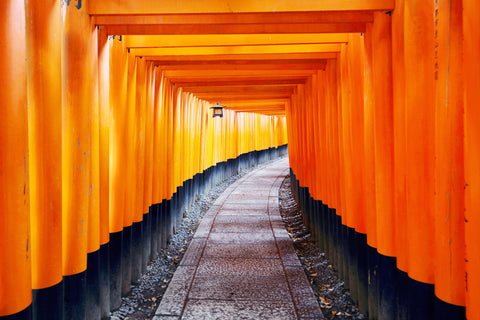Torii Gates: Japan’s Famous Arches With Mysterious Origins

Jump to:
Torii gates are seen all over Japan — and they’ve been around for centuries. But why do they exist in the first place? This article will explain the meaning of torii, their origins and even recommend some famous ones to visit.
What Is A Torii Gate?

Torii gates (or just torii for short) are traditional Japanese arches that usually mark the entrance to Shinto shrines (although they are occasionally present at Buddhist temples and other locations, too). Torii have a very specific shape consisting of two vertical pillars with two horizontal beams across the top. They are usually made of wood or stone, but other materials can be used, too (even plastic or metal). They are almost always painted vermillion (a sort of red-orange color) or left in a natural state (unpainted). On a spiritual level, torii gates are seen as markers that indicate the boundary between the human and sacred worlds. There can be various levels of torii, as well. For example, there is always the first entry gate, but there can be a secondary or third gate for deeper areas within the shrine.
History Of Torii Gates: Unknown Origin
As Professor Mori Mizue of Kokugakuin University explained, historians can’t agree about exactly where the torii came from. “The origin of torii has been explained by numerous theories; some claim that they are indigenous to Japan, while others view them as having [been] imported from abroad.” He also explains that even the word itself, “torii,” has debatable origins. Some say it could have come from the word “bird perch” (toriiyasu or toriita) or “pass through and enter” (toriiru). Japanese neuroscientist and writer, Ken Mogi, talks more about the word origin on YouTube.
The Meaning And Importance Of Torii

The significance of torii gates is mostly defined by the shrine or location they are attached to. Torii are usually just entryways and markers that indicate the site of a location that Japanese people feel is important or sacred.
To understand torii well, you might want to understand a bit about Shinto first. The Association of Shinto Shrines in Japan says that observers of the Shinto faith worship ancestors as family guardians and show respect to many different kami (deities or gods). The association also says “There are kami of the mountains, and kami of the sea. Kami are all around us, in every thing and every person.” Many of these kami have their own shrines, and torii mark the location of (and are the entryway into) these shrines. This video has an excellent explanation of Shinto in relation to shrines, kami and torii.
Religion in Japan?
So, you might have heard that Japanese people aren’t very religious. And, it’s true that the number of people adhering to a religion in Japan is steadily declining. If that’s the case, then why are there all these shrines and torii everywhere? Well, even if they don’t call themselves religious, many Japanese people still practice some Shinto traditions. You could compare it to non-Christian Americans celebrating Christmas, perhaps. It’s become more of a part of mainstream culture than a religious thing. With this in mind, foreigners are welcome to visit Shinto shrines and pass through the torii gates regardless of their own religious or spiritual beliefs. “Shinto has no founder, no holy book, and not even the concept of religious conversion, but Shinto places value in harmony with nature and virtues such as ’Magokoro (sincere heart)’” — according to Meiji Jingu shrine.
Types Of Torii Gates
There are various styles of torii that can be seen in Japan, and they can be split into two main groups: shinmei and myōjin. The main characteristic of the shinmei torii are the straight beams that run horizontally along the top. The myōjin, on the other hand, have a bit of a curve. Japan Architecture has some interesting diagrams of each, along with some detailed terminology on torii parts.
Most Popular Torii Gates To Visit

It’s so hard to say which torii is the best to visit in Japan, but of course there are some really popular ones you might want to see. Here are a few notable ones.
Fushimi Inari Taisha, Kyoto - This is maybe the most well-known and most-pictured torii spot in Japan. You know it — the one with literally thousands of torii lined up like a tunnel of red-orange (vermillion) gates. These torii are called the Senbon Torii. Besides being a popular choice for instagram pics, walking through the vibrant red gates in contrast with the lush green forest is an almost spiritual experience (and also very tiring if you’ve already been walking all day). To reach Fushimi Inari Taisha, take a train from Kyoto Station to Inari Station on the JR Nara Line. The shrine is about a five-minute walk from the station.
Itsukushima Shrine, Miyajima - This is definitely worth visiting, as it’s one of the most unique of the torii in Japan. Located on the island of Miyajima near Hiroshima, Itsukushima Shrine is famous for its "floating" torii gate. This iconic gate stands in the waters of the Seto Inland Sea and people say it appears to float during high tide. Speaking of the tide, you’ll probably want to check when the tide is up and/or down before you visit. When the tide is low, you can actually walk up to the torii. To get there, go to Hiroshima first (you might take the Shinkansen). Next, take a train to Miyajimaguchi Station from Hiroshima. Then, take a ferry to Miyajima Island. Itsukushima Shrine is within walking distance from the ferry terminal, and you’ll be able to see the giant torii on the water. For the ferry, you have more than one option, so take a look at what’s available.
Meiji Shrine, Tokyo - This shrine is located in Tokyo's busy Shibuya district (near Harajuku Station). It’s incredible how you can be so close to the super busy city with tons of pedestrians and then walk right into this peaceful, green space. As Japan Journeys said, “The Harajuku entrance to the Meiji Shrine grounds is marked by a towering wooden torii gate, standing 40 feet tall and made from 1,600 year old cypress.” It’s incredible. The tranquil atmosphere along with the beautiful forest and shrine complex make it a must-see. One way to get there is by going to Harajuku Station. From the station, take the West exit, and Meiji Shrine’s huge wooden torii will be right in front of you.
Unusual Torii

Not every Japanese arch is the same (which you’ve probably realized already if you’ve read this far). They come in many styles and colors and are placed at all kinds of locations. Here are a few unusual torii.
Sakurai Shrine, Fukuoka - This may be the most beautiful torii of all. It’s pure white, and it stands right on the beach. When you look through the archway from the right angle, you can see a pair of large rocks right in the center. It’s not exactly close to the main part of the city (about an hour away), but you can get there by taking a bus and a train. In Fukuoka, take the local Chikuzen-Maebaru line from Hakata station. Then, get off the train at Kyūdai-Gakkentoshi station and catch the Nishinoura bus line all the way to Futamigaura station. It will be just about a minute walk from there. Note: Don’t forget to grab water at the convenience store before you take off — stay hydrated!
Hoshiimo Jinja Shrine, Ibaraki - This unique set of Japanese arches is unique because of its color. The torii here are yellow. The color seems to be related to the production of the hoshi-imo snack in the region — a sweet potato snack with a golden, yellow-ish color. To get there from Tokyo Station, take the Hitachi or Tokiwa line to Katsuta Station. Next, take the Ajigaura to its last stop, Ajigaura Station. From there it’s just a couple of minutes away (walking).
AiiRO Cafe, Tokyo - Okay, this one doesn’t usually pop up on any torii lists, but it’s one of the only (maybe the only) rainbow torii in Japan. This torii doesn’t have any religious meaning, according to staff, but the rainbow coloring does have another meaning — it marks an LGBTQIA+ welcoming space. It’s actually in front of a “mix bar” (that’s basically a gay bar that is open to all kinds of people) called AiiRO Cafe. So, if you want to grab a drink and check out Tokyo’s LGBTQIA+ nightlife, stop by! To get there from Tokyo Station, take the Marunouchi Line to Shinjuku Gyoenmae Station. It’s about a 6 minute walk from there.
Some Torii Tips
- When you go through the torii (walk under it), you should bow once. This is true for both entering and leaving.
- As Meiji Shrine recommends: “Going through the torii archway, you will see the sando (the path leading up to the shrine). Please note that you should not walk in the center of the sando as it is considered to be a path where the gods walk.”
- Don’t worry too much about getting everything right when trying to observe Japanese customs surrounding torii and shrines — just do your best. People understand that foreigners will not know everything.

0 comments